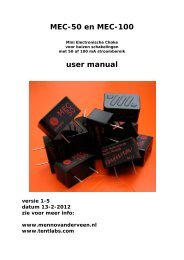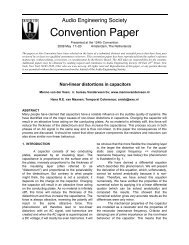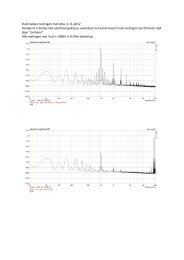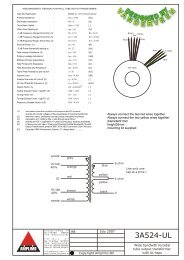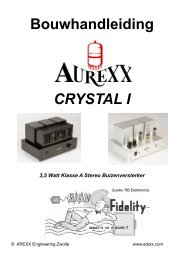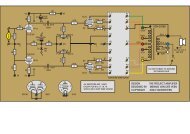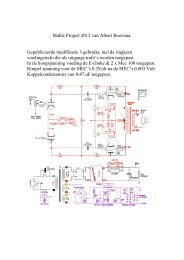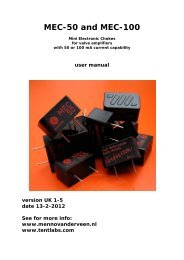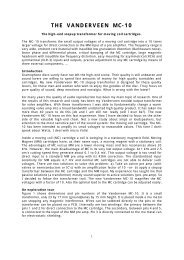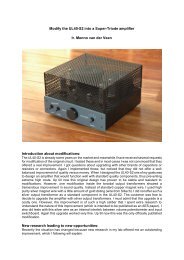Convention Paper - Menno van der Veen
Convention Paper - Menno van der Veen
Convention Paper - Menno van der Veen
Create successful ePaper yourself
Turn your PDF publications into a flip-book with our unique Google optimized e-Paper software.
<strong>Menno</strong> <strong>van</strong> <strong>der</strong> <strong>Veen</strong><br />
Signal weakening in audio transformers<br />
will be just at B max timely, preventing nasty<br />
distortion un<strong>der</strong> this condition.<br />
4.3. Designing transformers<br />
I can't help feeling the need to express that<br />
designing transformers is an art. If you cure here,<br />
you damage there. For instance, using Metglas<br />
cures at low levels, but its overdrive behavior is<br />
sharp nasty sounding limiting. Designing for 0.5 ⋅<br />
B max makes the transformers heavy and more<br />
expensive. Applying gaps costs money as well.<br />
And what to say about the frequency range I did<br />
not discuss here: environment of 20 kHz and<br />
larger. There leakage and internal capacitances<br />
play a leading role and then toroidal is the most<br />
favorable shape, see [1],[6] .<br />
It is not the aim of this paper to discuss all. When<br />
only focusing on the 20 Hz to 1 kHz frequency<br />
range, then the perm behavior is dominant. But the<br />
transformer designer has to consi<strong>der</strong> at least the<br />
range from 20 Hz to 20 kHz and therefore shall<br />
have to find a balance between all the goodies and<br />
baddies of the different solutions. Fortunately, the<br />
customer, who buys a transformer, can cure the<br />
effect discussed by applying special valves or any<br />
kind of feedback.<br />
5. CONCLUSIONS<br />
In earlier work a model was created that describes<br />
the effect of magnetic permeability collapse at very<br />
low and very high flux density levels inside a<br />
transformer core. It was calculated that this<br />
collapse is subjectively noticeable as an extra<br />
weakening in the frequency range of 20 Hz to 1<br />
kHz, taking the threshold of hearing and the<br />
sensitivity of the loudspeakers into account. In this<br />
paper a method is given how to measure this perm<br />
effect in existing valve amplifiers. Measurement<br />
and theoretical model show total agreement. Two<br />
methods are formulated to prevent the extra<br />
weakening: apply low plate resistance valves or<br />
use feedback, which has the same effect. The<br />
second method focuses on high perm steel<br />
selection and the core shape of the transformer and<br />
the linearising effect of a core gap. It is noted that<br />
the cure of weakening in the 20 Hz to 1 kHz<br />
frequency range might cause problems elsewhere<br />
in the frequency range of the transformer. In<br />
summary: perm collapse has influence on the<br />
transfer, it can be cured inside or outside the<br />
transformer, but be warned: "curing here might<br />
damage elsewhere".<br />
6. REFERENCES<br />
[1]: <strong>Menno</strong> <strong>van</strong> <strong>der</strong> <strong>Veen</strong>; "Theory and Practice<br />
of Wide Bandwidth Toroidal Output<br />
Transformers"; 97th AES-<strong>Convention</strong> 1994; San<br />
Francisco, preprint 3887.<br />
[2]: <strong>Menno</strong> <strong>van</strong> <strong>der</strong> <strong>Veen</strong>; "Modeling Power<br />
Tubes and their Interaction with Output<br />
Transformers"; 104th AES convention,<br />
Amsterdam, 1998; preprint 4643.<br />
[3]: Pierre Touzelet & <strong>Menno</strong> <strong>van</strong> <strong>der</strong> <strong>Veen</strong>;<br />
"Small signal analysis for generalized push-pull<br />
amplifier topology"; 112th AES convention, 2002<br />
Munich, paper 5587.<br />
[4]: <strong>Menno</strong> <strong>van</strong> <strong>der</strong> <strong>Veen</strong> & Pierre Touzelet;<br />
“New Vacuum Tube and Output Transformer<br />
Models applied to the Quad II valve amplifier";<br />
114th AES convention, 2003 Amsterdam, paper<br />
5748.<br />
[5]: <strong>Menno</strong> <strong>van</strong> <strong>der</strong> <strong>Veen</strong>; “Universal System and<br />
Output Transformer for Valve Amplifiers”; 118th<br />
AES convention, 2005 Barcelona; paper 6347.<br />
[6]: <strong>Menno</strong> <strong>van</strong> <strong>der</strong> <strong>Veen</strong>; "Mo<strong>der</strong>n High-end<br />
Valve Amplifiers based on toroidal output<br />
transformers"; ISBN 0-905705-63-7,<br />
www.elektor.com<br />
[7]: <strong>Menno</strong> <strong>van</strong> <strong>der</strong> <strong>Veen</strong>; "High-end Valve<br />
Amplifiers 2"; ISBN 978-0-905705-90-3,<br />
www.elektor.com<br />
[8]: <strong>Menno</strong> <strong>van</strong> <strong>der</strong> <strong>Veen</strong>; "Low level audio<br />
signal transfer through transformers conflicts with<br />
permeability behavior inside their cores"; <strong>Paper</strong><br />
7125, 122nd AES-convention, 2007 May 5-8,<br />
Vienna Austria.<br />
[9]: <strong>Menno</strong> <strong>van</strong> <strong>der</strong> <strong>Veen</strong> & Hans <strong>van</strong> Maanen;<br />
"Non-linear Distortions in Capacitors"; 124th AES<br />
convention, 2008 Amsterdam, paper 7500.<br />
[10]: Ivo Mateljan; "Arta/Steps/Imp";<br />
www.fesb.hr/~mateljan/arta<br />
[11]: www.menno<strong>van</strong><strong>der</strong>veen.nl<br />
AES 130th <strong>Convention</strong>, London, UK, 2011 May 13–16<br />
Page 8 of 8



